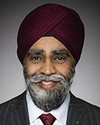I'm happy to discuss that.
As I mentioned earlier, first and foremost, we had a request from Global Affairs early on to look at the security of our Canadian embassy personnel, which we normally get. Then, on July 27, we received a request from Global Affairs to support the IRCC evacuation of the remainder of the Canadian personnel and the permanent residents.
On July 30, we gave approval to the Canadian Armed Forces to deploy to Afghanistan to support that evacuation.
The chartered flights, working with Global Affairs, started on August 4. On August 13, the additional measures were announced by the minister of immigration at the time to include additional groups, as I had mentioned—vulnerable groups such as women leaders, humanitarian, defence, journalists, and persecuted and religious minorities, which included the Afghan Sikhs.
On August 15, because of the safety of the Canadian embassy personnel—the Taliban had entered Kabul—we had to evacuate everybody and had to cease operations. A lot of work happened in between. On August 19, we were able to determine that we could reinsert our folks, with our allies, back into the Kabul airport to resume the evacuation.
Then, in managing that, there was a whole lot of stuff that happened in between that resulted in us completing everything by the 27th. We had no choice after that but to completely depart.




